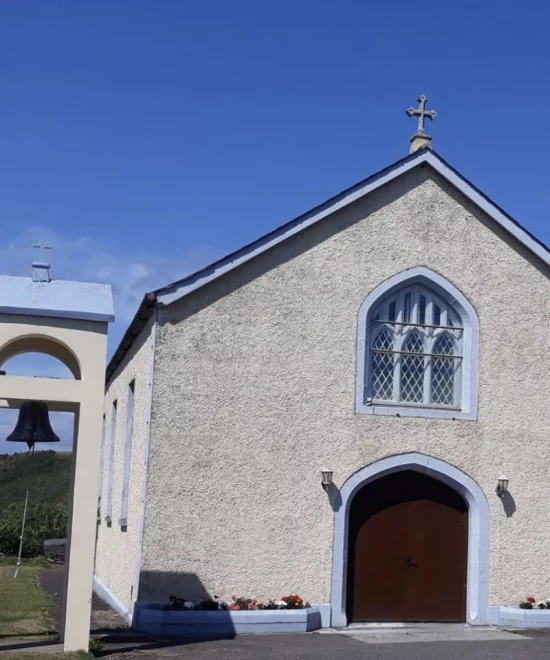St. Mary's Church, Saleen, Bonmahon
History
In 1840 about 2,000 people lived in Bonmahon. It had 2 hotels, a pawn shop, creamery, bacon factory, several shops and 21 public houses. The mine supervisors were worried that drunkenness was affecting the work in the mines, so in 1842 they built a Temperance Hall.
Temperance men were employed to try to keep the workers out of the pubs. They were successful and the miners spent their free time in the Temperance Hall involved in social activities and practicing their music for the Temperance Band. The hall cost £1,000 to build and £400 was subscribed by the miners. The remainder was collected in England and the United States by Rev. James Power, C.C.
During the Famine years (1845-1847) the hall was used as a depot from which the countless, destitute, starving people were supplied with provisions of food and other necessities. In 1997 a Festival of Flowers was held in the church to commemorate the 150th anniversary of the Famine. The following are extracts from “The Comeraghs: Famine, Eviction and Revolution”; by Seán and Síle Murphy. They were reproduced in a booklet for the Festival.
Fr James Power C.C and the Devon Commission 1844 “There is very extensive employment in my neighbourhood in the mines of Knockmahon, but they have to pay a very high rent for the houses in which they live, and that is owing to the unwillingness of the landlord to have houses built for his tenantry to accommodate the labouring classes. The rents are so high that they stow themselves away in these houses, and we have two or three families living in these rooms.”
September 1845 “Very distressing accounts are received of the damage done to the potato crop especially on lands adjoing the sea coast.” (Waterford Chronicle)
Medical report Bonmahon December 1845: Dr Walker reports a great increase in fever in the district, due to the scarcity and high cost of food. From 150 -200 were unemployed in the village.
Rev David Doudney 1847: Describing the conditions in Bonmahon on his arrival from Templemore he says; “Ones heart is perfectly sickened in walking through the village itself and beholding the filth, the wretchedness and the misery that presented itself on every hand”
Inquests in Bonmahon, 1847: An inquest was held on the skeletons of Johanna Mahony, Mary Heffernan and Jeremiah Mulcahy. The jury returned a verdict of death by starvation A week later an inquest was held on the deaths of Nicholas White and Johanna Murnane, found by the roadside. In January 1847 an inquest was held on a man found dead on his way to relief works. The mines closed in Allihes, Co. Cork, and many miners and their families walked to Bonmahon seeking employment. Patrick Kelly died in Bonmahon and six children died on the way.
The hall was converted into a chapel in 1854 by Rev. Roger Power, Parish Priest of Kill and Newtown. It was in that year that the present sacristy and another addition at the east side were built. The people truly appreciated, that for the first time, they had a permanent house of worship in their midst.
With the Second Vatican Council in the 1960s came many changes. No longer was the mass said in Latin by the priest with his back to the people. The sanctuary was changed and a new altar put in place, so that the priest could say mass in English, facing the people. The sanctuary lamp was moved to the side and the pulpit ceased to be used. Few changes were made to the church since. Electricity was installed, the roof repaired, new windows were donated, and the church was painted and carpeted.
At the beginning of the new millennium it was decided to upgrade the church and with the support of Fr. Brendan Crowley, Parish Priest and Fr. Michael Kennedy, curate, a committee was formed by the parishioners, for the task. Their main priorities were, a new porch, a new entrance to the gallery, upgrading lighting, installing modern heating, a new back door, painting, toilet facilities and modernising the sacristy.


